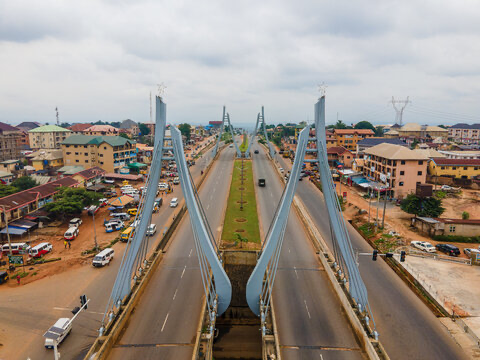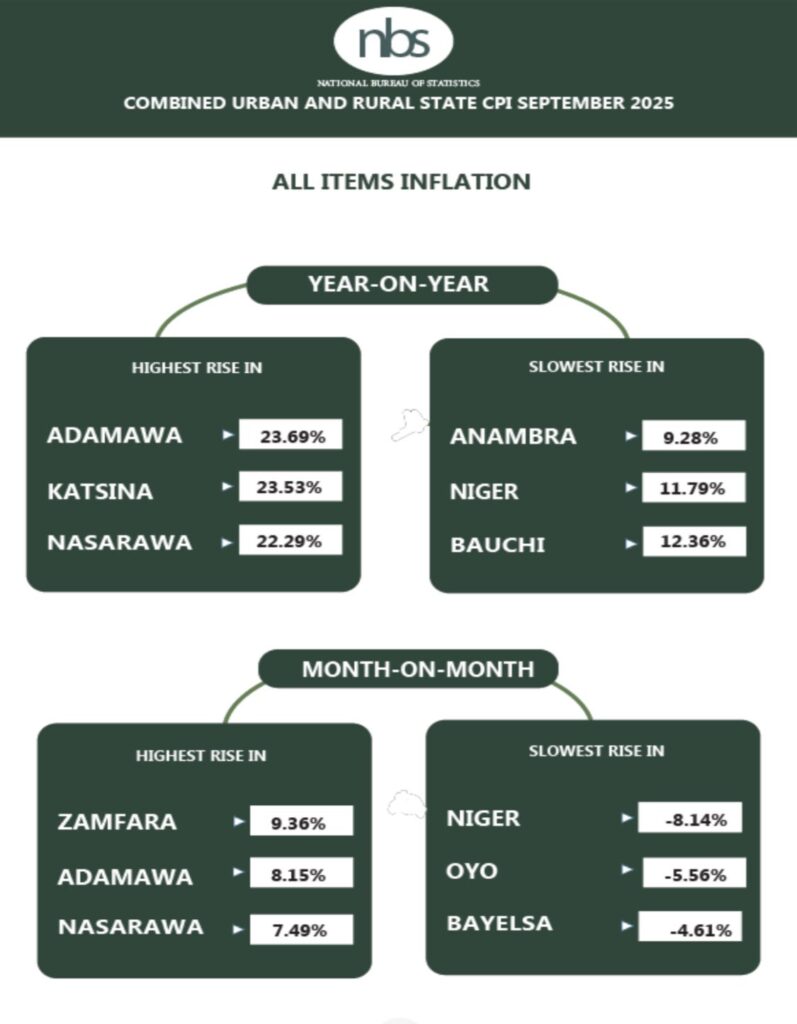
Anambra State Tops List Of 10 Most Affordable States to Live in Nigeria in September 2025
In September 2025, the cost of living across Nigerian states showed wide variations, with some regions emerging as far more affordable than others, according to the latest Consumer Price Index (CPI) report from the National Bureau of Statistics (NBS).
Nigeria’s headline inflation rate eased to 18.02% in September, reflecting the fourth consecutive month of decline. However, affordability levels still vary greatly across states, as some regions recorded inflation rates significantly below the national average.
States with lower inflation rates typically experience a slower rise in prices of goods and services, providing residents with greater purchasing power and more stable household budgets.
Below is the updated ranking of the 10 most affordable states to live in Nigeria in September 2025, based on official NBS data.
10. Jigawa – 16.3%
Jigawa State, located in North-West Nigeria, recorded an annual inflation rate of 16.3%, a sharp drop from 23.1% in August.
The state’s food inflation also fell dramatically from 23.3% to 12.1% during the same period.
Experts attribute the improvement to agricultural initiatives such as the Workers’ Agricultural Support Programme, which benefited over 8,800 civil servants, and large-scale farming schemes like the Rice Millionaire Project and Special Agro-Processing Zones. These programs have boosted food production and enhanced local food security.
9. Akwa Ibom – 16.3%
Akwa Ibom ranked just above Jigawa, with a 16.3% annual inflation rate, down from 20.7% in August. The state saw one of the most dramatic drops in food inflation, from 29.9% to 9%.
Governor Umo Eno’s Agriculture and Food Security Committee, inaugurated earlier in the year, has been instrumental in strengthening local food production.
The state’s N695 billion supplementary budget, recently proposed by the executive council, also aims to fund a new minimum wage, improve flood and erosion control, and expand public transport through the Ibom CNG Mass Transit project.
8. Imo – 15.8%
Imo State reported an inflation rate of 15.8%, a decline from 18.3% in August, while food inflation dropped from 24.3% to 12.4%.
Once tagged one of Nigeria’s most expensive states, Imo has seen relief thanks to improved security conditions and better market stability. Affordable housing and easy access to local produce have also helped keep costs low.
7. Ebonyi – 14.8%
Ebonyi State recorded an annual inflation rate of 14.8%, a major improvement from 21.2% in August. However, food inflation slightly increased to 16.4%.
Despite its strong agricultural potential, challenges in transportation and food distribution continue to influence local prices. The state government has yet to announce new measures to address inflationary pressures.
6. Bayelsa – 14.8%
Bayelsa also posted a 14.8% inflation rate, down sharply from 23.8% in August.
The food inflation rate, however, rose to 21.9% — largely due to supply chain disruptions and the state’s heavy reliance on food imports.
As a major producer of plantain, cassava, rice, and yam, the state could benefit from investing more in processing and logistics to stabilise food prices.
5. Sokoto – 14%
Sokoto’s inflation rate fell to 14% in September, down from 22.5% in August. However, food inflation saw an uptick, rising from 6.3% to 13%.
The state government’s June salary loan initiative for civil servants helped cushion short-term inflation impacts, though further economic interventions are needed to sustain long-term affordability.
4. Enugu – 12.4%
Enugu recorded a 12.4% inflation rate, down from 14.2% in August, alongside a drop in core inflation.
Transport costs decreased following the completion of the Ninth Mile bypass, and a state rent relief initiative for public workers helped ease housing expenses.
However, food inflation remained elevated at 19.4%, driven by tomato blight and supply delays from northern markets. The government’s recent distribution of 40,000 bags of fertiliser is expected to help stabilise food supply in coming months.
3. Bauchi – 12.4%
Bauchi climbed to third place in September with an inflation rate of 12.4%, down from 15.3%.
Food inflation dropped significantly from 11.7% to 2.8%, reflecting better agricultural productivity and lower transport costs.
The reopening of the Bauchi–Jos expressway and release of grain reserves helped stabilise prices. The state also invested ₦45 billion to upgrade its fertiliser blending plant, boosting production capacity to 45 tonnes per hour — a move expected to further support farmers and reduce food costs.
2. Niger – 11.8%
Niger State recorded an impressive improvement, with inflation dropping to 11.8% from 25.5% in August.
Despite recent flooding in Mokwa, the government rolled out ₦8 billion in relief and infrastructure funds and distributed food items to affected communities.
Governor Mohammed Umaru Bago also secured a $100 million livestock export deal with the Saudi Export and Import Bank, strengthening the state’s agribusiness profile.

1. Anambra – 9.3%
Anambra State topped the list as the most affordable state to live in Nigeria in September 2025, recording an inflation rate of just 9.3%, down from 14.2% in August.
The state’s food inflation dropped to 8.4%, making it Nigeria’s best-performing region in cost control.
Experts credit this to the digitalisation of payment systems at Onitsha Main Market, which reduced transaction costs, and the installation of boreholes in rural areas, cutting household utility expenses.
Summary: Nigeria’s Most Affordable States (September 2025)
| Rank | State | Inflation Rate (%) |
|---|---|---|
| 1 | Anambra | 9.3 |
| 2 | Niger | 11.8 |
| 3 | Bauchi | 12.4 |
| 4 | Enugu | 12.4 |
| 5 | Sokoto | 14.0 |
| 6 | Bayelsa | 14.8 |
| 7 | Ebonyi | 14.8 |
| 8 | Imo | 15.8 |
| 9 | Akwa Ibom | 16.3 |
| 10 | Jigawa | 16.3 |
Conclusion
The decline in Nigeria’s inflation rate has offered much-needed relief to households nationwide. However, regional differences remain, with states like Anambra, Niger, and Bauchi leading the way in affordability.
As Nigeria continues to stabilise its economy, state-level policies promoting agriculture, infrastructure, and digital innovation will play a crucial role in reducing living costs and ensuring sustainable growth.
About Author
Discover more from BillionBill
Subscribe to get the latest posts sent to your email.


